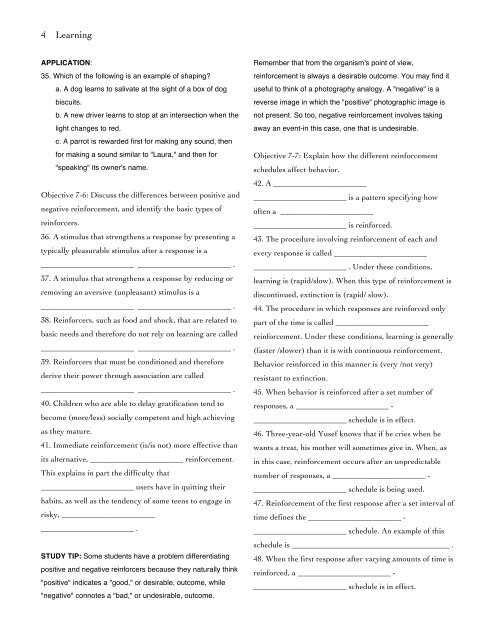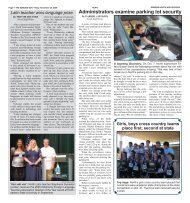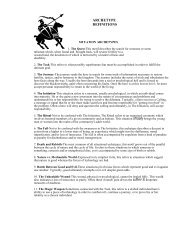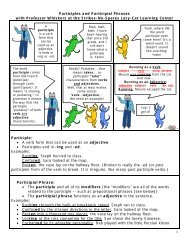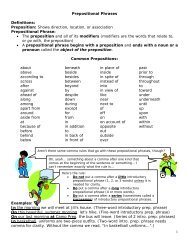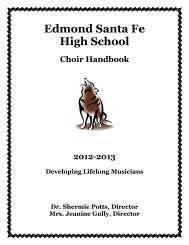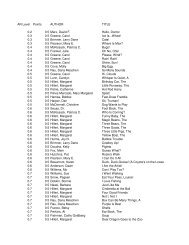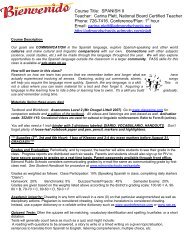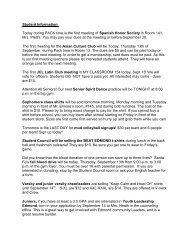SG-Ch 7 Learning.pdf - Edmond Public Schools
SG-Ch 7 Learning.pdf - Edmond Public Schools
SG-Ch 7 Learning.pdf - Edmond Public Schools
You also want an ePaper? Increase the reach of your titles
YUMPU automatically turns print PDFs into web optimized ePapers that Google loves.
4<br />
<strong>Learning</strong><br />
APPLICATION:<br />
35. Which of the following is an example of shaping?<br />
a. A dog learns to salivate at the sight of a box of dog<br />
biscuits.<br />
b. A new driver learns to stop at an intersection when the<br />
light changes to red.<br />
c. A parrot is rewarded first for making any sound, then<br />
for making a sound similar to "Laura," and then for<br />
"speaking" its owner's name.<br />
Objective 7-6: Discuss the differences between positive and<br />
negative reinforcement, and identify the basic types of<br />
reinforcers.<br />
36. A stimulus that strengthens a response by presenting a<br />
typically pleasurable stimulus after a response is a<br />
_______________________ _______________________ .<br />
37. A stimulus that strengthens a response by reducing or<br />
removing an aversive (unpleasant) stimulus is a<br />
_______________________ _______________________ .<br />
38. Reinforcers, such as food and shock, that are related to<br />
basic needs and therefore do not rely on learning are called<br />
_______________________ _______________________ .<br />
39. Reinforcers that must be conditioned and therefore<br />
derive their power through association are called<br />
_______________________ _______________________ .<br />
40. <strong>Ch</strong>ildren who are able to delay gratification tend to<br />
become (more/less) socially competent and high achieving<br />
as they mature.<br />
41. Immediate reinforcement (is/is not) more effective than<br />
its alternative, _______________________ reinforcement.<br />
This explains in part the difficulty that<br />
_______________________ users have in quitting their<br />
habits, as well as the tendency of some teens to engage in<br />
risky, _______________________<br />
_______________________ .<br />
STUDY TIP: Some students have a problem differentiating<br />
positive and negative reinforcers because they naturally think<br />
"positive" indicates a "good," or desirable, outcome, while<br />
"negative" connotes a "bad," or undesirable, outcome.<br />
Remember that from the organism's point of view,<br />
reinforcement is always a desirable outcome. You may find it<br />
useful to think of a photography analogy. A "negative" is a<br />
reverse image in which the "positive" photographic image is<br />
not present. So too, negative reinforcement involves taking<br />
away an event-in this case, one that is undesirable.<br />
Objective 7-7: Explain how the different reinforcement<br />
schedules affect behavior.<br />
42. A _______________________<br />
_______________________ is a pattern specifying how<br />
often a _______________________<br />
_______________________ is reinforced.<br />
43. The procedure involving reinforcement of each and<br />
every response is called _______________________<br />
_______________________ . Under these conditions,<br />
learning is (rapid/slow). When this type of reinforcement is<br />
discontinued, extinction is (rapid/ slow).<br />
44. The procedure in which responses are reinforced only<br />
part of the time is called _______________________<br />
reinforcement. Under these conditions, learning is generally<br />
(faster /slower) than it is with continuous reinforcement.<br />
Behavior reinforced in this manner is (very /not very)<br />
resistant to extinction.<br />
45. When behavior is reinforced after a set number of<br />
responses, a _______________________ -<br />
_______________________ schedule is in effect.<br />
46. Three-year-old Yusef knows that if he cries when he<br />
wants a treat, his mother will sometimes give in. When, as<br />
in this case, reinforcement occurs after an unpredictable<br />
number of responses, a _______________________ -<br />
_______________________ schedule is being used.<br />
47. Reinforcement of the first response after a set interval of<br />
time defines the _______________________ -<br />
_______________________ schedule. An example of this<br />
schedule is _______________________________________ .<br />
48. When the first response after varying amounts of time is<br />
reinforced, a _______________________ -<br />
_______________________ schedule is in effect.


